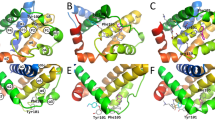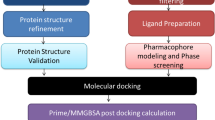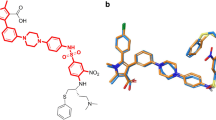Abstract
Ensemble-based virtual screening using different conformations of a target protein is gaining popularity, as it can leverage information from target flexibility for effective lead identification. In this paper, molecular dynamics simulation followed by RMSD-based clustering was employed to generate and choose distinct conformations of Bcr-Abl. Three representative structures from the most-populated clusters along with the crystal structure conformation (PDBID: 3K5V) were used to perform docking-based virtual screening of 14,400 compounds (in the Maybridge database) in order to identify potential allosteric site binders. Seven compounds found as hits in at least three of the four virtual screenings had higher Glide docking scores than the co-crystallized allosteric inhibitor GNF-2. Detailed computational analyses of the seven hits identified SEW02675 (ΔG bind = −164.92 kJ/mol with the wild-type (wt) Bcr-Abl and −167.37 kJ/mol with the T334I Bcr-Abl mutant) as a better allosteric site binder with both the wt and the mutant Bcr-Abl protein than the reference allosteric inhibitor GNF-2 (ΔG bind = −103.12 with wt and −142.96 kJ/mol with T334I). Moreover, the presence of SEW02675 in the allosteric site enhanced the binding of imatinib (ΔG bind = −367.58 with wt and −294.56 kJ/mol with T334I) to the ATP sites of the wt and the mutant Bcr-Abl. However, when GNF-2 was present in the allosteric site, the binding of imatinib (ΔG bind = −351.76 with wt and −273.94 kJ/mol with T334I) to the ATP site was weaker. The in silico findings suggest that SEW02675 could be used in combination with imatinib to treat chronic myeloid leukemia, and that it could help to overcome resistance due to T334I Bcr-Abl mutation.

Virtual screening strategy to identify allosteric inhbitors of Bcr-Abl for the treatment of Chronic myeloid leukemia.







Similar content being viewed by others
References
Xia G, Xue M, Liu L et al (2011) Potent and novel 11β-HSD1 inhibitors identified from shape and docking based virtual screening. Bioorg Med Chem Lett 21:5739–5744. doi:10.1016/j.bmcl.2011.08.019
Bottegoni G, Rocchia W, Rueda M et al (2011) Systematic exploitation of multiple receptor conformations for virtual ligand screening. PLoS One 6(5):e18845. doi:10.1371/journal.pone.0018845
Osguthorpe DJ, Sherman W, Hagler AT (2012) Generation of receptor structural ensembles for virtual screening using binding site shape analysis and clustering. Chem Biol Drug Des 80:182–193. doi:10.1111/j.1747-0285.2012.01396.x
Totrov M, Abagyan R (2008) Flexible ligand docking to multiple receptor conformations: a practical alternative. Curr Opin Struct Biol 18:178–184. doi:10.1016/j.sbi.2008.01.004
Lin JH, Perryman AL, Schames JR, McCammon JA (2002) Computational drug design accommodating receptor flexibility: the relaxed complex scheme. J Am Chem Soc 124:5632–5633. doi:10.1021/ja0260162
Wong CF, Kua J, Zhang Y et al (2005) Molecular docking of balanol to dynamics snapshots of protein kinase A. Proteins 61:850–858. doi:10.1002/prot.20688
Cavasotto CN, Abagyan RA (2004) Protein flexibility in ligand docking and virtual screening to protein kinases. J. Mol. Biol. 337:209–225. doi:10.1016/j.jmb.2004.01.003
Amaro RE, Li WW (2010) Emerging methods for ensemble-based virtual screening. Curr Top Med Chem 10:3–13. doi:10.2174/156802610790232279
Meagher KL, Carlson HA (2004) Incorporating protein flexibility in structure-based drug discovery: using HIV-1 protease as a test case. J Am Chem Soc 126:13276–13281. doi:10.1021/ja0469378
Carlson HA, Masukawa KM, Rubins K et al (2000) Developing a dynamic pharmacophore model for HIV-1 integrase. J Med Chem 43:2100–2114. doi:10.1021/jm990322h
Hantschel O, Superti-Furga G (2004) Regulation of the c-Abl and Bcr-Abl tyrosine kinases. Nat Rev Mol Cell Biol 5:33–44. doi:10.1038/nrm1280
Lozzio CB, Lozzio BB (1975) Human chronic myelogenous leukemia cell-line with positive Philadelphia chromosome. Blood 45:321–334
Daley GQ, Van Etten RA, Baltimore D (1990) Induction of chronic myelogenous leukemia in mice by the P210bcr/abl gene of the Philadelphia chromosome. Science 247:824–830. doi:10.1126/science.2406902
Huse M, Kuriyan J (2002) The conformational plasticity of protein kinases. Cell 109:275–282. doi:10.1016/S0092-8674(02)00741-9
Battistutta R, De Moliner E, Sarno S et al (2001) Structural features underlying selective inhibition of protein kinase CK2 by ATP site-directed tetrabromo-2-benzotriazole. Protein Sci 10:2200–2206. doi:10.1110/ps.19601
Shah NP, Nicoll JM, Nagar B et al (2002) Multiple BCR-ABL kinase domain mutations confer polyclonal resistance to the tyrosine kinase inhibitor imatinib (STI571) in chronic phase and blast crisis chronic myeloid leukemia. Cancer Cell 2:117–125. doi:10.1016/S1535-6108(02)00096-X
Skora L, Mestan J, Fabbro D et al (2013) NMR reveals the allosteric opening and closing of Abelson tyrosine kinase by ATP-site and myristoyl pocket inhibitors. Proc Natl Acad Sci 110:E4437–E4445. doi:10.1073/pnas.1314712110
O’Hare T, Eide CA, Deininger MW (2008) New Bcr-Abl inhibitors in chronic myeloid leukemia: keeping resistance in check. Expert Opin. Investig. Drugs 17:865–878. doi:10.1517/13543784.17.6.865
O’Hare T, Shakespeare WC, Zhu X et al (2009) AP24534, a pan-BCR-ABL inhibitor for chronic myeloid leukemia, potently inhibits the T315I mutant and overcomes mutation-based resistance. Cancer Cell 16:401–412. doi:10.1016/j.ccr.2009.09.028
Deng X, Okram B, Ding Q et al (2010) Expanding the diversity of allosteric Bcr-Abl inhibitors. J Med Chem 53:6934–6946. doi:10.1021/jm100555f
Gray NS, Fabbro D (2014) Discovery of allosteric Bcr-Abl inhibitors from phenotypic screen to clinical candidate. Methods Enzymol. 548:173–188. doi:10.1016/B978-0-12-397918-6.00007-0
Deininger MWN, Druker BJ (2003) Specific targeted therapy of chronic myelogenous leukemia with imatinib. Pharmacol Rev 55:401–423. doi:10.1124/pr.55.3.4
Deininger M, Buchdunger E, Druker BJ (2005) The development of imatinib as a therapeutic agent for chronic myeloid leukemia. Blood 105:2640–2653. doi:10.1182/blood-2004-08-3097
Zhang J, Adrián FJ, Jahnke W et al (2010) Targeting Bcr-Abl by combining allosteric with ATP-binding-site inhibitors. Nature 463:501–506. doi:10.1038/nature08675
Madhavi Sastry G, Adzhigirey M, Day T et al (2013) Protein and ligand preparation: parameters, protocols, and influence on virtual screening enrichments. J Comput Aided Mol Des 27:221–234. doi:10.1007/s10822-013-9644-8
Sarvagalla S, Singh VK, Ke Y-Y et al (2014) Identification of ligand efficient, fragment-like hits from an HTS library: structure-based virtual screening and docking investigations of 2H- and 3H-pyrazolo tautomers for Aurora kinase a selectivity. J Comput Aided Mol Des 29:89–100. doi:10.1007/s10822-014-9807-2
Friesner RA, Murphy RB, Repasky MP et al (2006) Extra precision Glide: docking and scoring incorporating a model of hydrophobic enclosure for protein–ligand complexes. J Med Chem 49:6177–6196. doi:10.1021/jm051256o
Bochevarov AD, Harder E, Hughes TF et al (2013) Jaguar: a high-performance quantum chemistry software program with strengths in life and materials sciences. Int J Quantum Chem 113:2110–2142. doi:10.1002/qua.24481
Berendsen HJC, van der Spoel D, van Drunen R (1995) GROMACS: a message-passing parallel molecular dynamics implementation. Comput Phys Commun 91:43–56. doi:10.1016/0010-4655(95)00042-E
Huang W, Lin Z, Van Gunsteren WF (2011) Validation of the GROMOS 54A7 force field with respect to β-peptide folding. J Chem Theory Comput 7:1237–1243. doi:10.1021/ct100747y
Ke Y-Y, Singh VK, Coumar MS et al (2015) Homology modeling of DFG-in FMS-like tyrosine kinase 3 (FLT3) and structure-based virtual screening for inhibitor identification. Sci Rep 5:11702. doi:10.1038/srep11702
Cocco S, Monasson R, Weigt M (2013) From principal component to direct coupling analysis of coevolution in proteins: low-eigenvalue modes are needed for structure prediction. PLoS Comput Biol 9:e1003176. doi:10.1371/journal.pcbi.1003176
Reddy MR, Reddy CR, Rathore RS et al (2013) Free energy calculations to estimate ligand-binding affinities in structure-based drug design. Curr Pharm Des 20:3323–3337. doi: 10.2174/13816128113199990604
Gilson MK, Zhou H-X (2007) Calculation of protein–ligand binding affinities. Annu Rev Biophys Biomol Struct 36:21–42. doi:10.1146/annurev.biophys.36.040306.132550
Dubey KD, Ojha RP (2012) Conformational flexibility, binding energy, role of salt bridge and alanine-mutagenesis for c-Abl kinase complex. J Mol Model 18:1679–1689. doi:10.1007/s00894-011-1199-9
Paissoni C, Spiliotopoulos D, Musco G, Spitaleri A (2014) GMXPBSA 2.1: a GROMACS tool to perform MM/PBSA and computational alanine scanning. Comput Phys Commun 186:105–107. doi:10.1016/j.cpc.2014.06.019
Cheng LS, Amaro RE, Xu D et al (2008) Ensemble-based virtual screening reveals potential novel antiviral compounds for avian influenza neuraminidase. J Med Chem 51:3878–3894. doi:10.1021/jm8001197
Joshi M, Rajpathak SN, Narwade SC, Deobagkar D (2016) Ensemble-based virtual screening and experimental validation of inhibitors targeting a novel site of human DNMT1. Chem Biol Drug Des 88:5–16. doi:10.1111/cbdd.12741
Ferrari AM, Wei BQ, Costantino L, Shoichet BK (2004) Soft docking and multiple receptor conformations in virtual screening. J Med Chem 47:5076–5084. doi:10.1021/jm049756p
Ai C, Li Y, Wang Y et al (2010) Investigation of binding features: effects on the interaction between CYP2A6 and inhibitors. J Comput Chem 31:1822–1831. doi:10.10021/jcc.21455
Queiroz AN, Gomes BAQ, Moraes WM, Borges RS (2009) A theoretical antioxidant pharmacophore for resveratrol. Eur J Med Chem 44:1644–1649. doi:10.1016/j.ejmech.2008.09.023
Tunç T, Koç Y, Açık L et al (2015) DNA cleavage, antimicrobial studies and a DFT-based QSAR study of new antimony(III) complexes as glutathione reductase inhibitor. Spectrochim Acta A 136:1418–1427. doi:10.1016/j.saa.2014.10.030
Sakkiah S, Lee KW (2012) Pharmacophore-based virtual screening and density functional theory approach to identifying novel butyrylcholinesterase inhibitors. Acta Pharmacol Sin 33:964–978. doi:10.1038/aps.2012.21
Druker BJ, Guilhot F, O’Brien SG, et al. (2006) Five-year follow-up of patients receiving imatinib for chronic myeloid leukemia. N Engl J Med 355:2408–2417. doi:10.1056/NEJMoa062867
Amadei A, Linssen ABM, Berendsen HJC (1993) Essential dynamics of proteins. Proteins 17:412–425. doi:10.1002/prot.340170408
Lee TS, Potts SJ, Kantarjian H et al (2008) Molecular basis explanation for imatinib resistance of BCR-ABL due to T315I and P-loop mutations from molecular dynamics simulations. Cancer 112:1744–1753. doi:10.1002/cncr.23355
Singh VK, Chang H-H, Kuo C-C et al (2016) Drug repurposing for chronic myeloid leukemia: in silico and in vitro investigation of DrugBank database for allosteric Bcr-Abl inhibitors. J Biomol Struct Dyn 1102:1–16. doi:10.1080/07391102.2016.1196462
Acknowledgements
A fellowship from Pondicherry University to VKS to pursue a Ph.D. and financial support from the University Grants Commission (F. no. 41-981/2012, SR), the Department of Biotechnology (BT/246/NE/TBP/2011/77), and the Science and Engineering Research Board (SR/FT/LS-64/2011), Govt. of India, to MSC are gratefully acknowledged.
Author information
Authors and Affiliations
Corresponding author
Electronic supplementary material
ESM 1
(PDF 621 kb)
Rights and permissions
About this article
Cite this article
Singh, V.K., Coumar, M.S. Ensemble-based virtual screening: identification of a potential allosteric inhibitor of Bcr-Abl. J Mol Model 23, 218 (2017). https://doi.org/10.1007/s00894-017-3384-y
Received:
Accepted:
Published:
DOI: https://doi.org/10.1007/s00894-017-3384-y




